HPLC Determination of Residual Primary Amine Content in Epoxy-Amine Adducts
LCGC Europe
LC Determination of Residual Primary Amine Content in Epoxy-Amine Adducts
Epoxy-amine adducts are an amine blend added to hot-sprayed aromatic isocyanate-containing polyurea sprays to change the curing time. Polyurea sprays are applied to metallic surfaces to create an antiâcorrosive coating and their curing time is influenced by the amine content. Amine content is normally determined using titration, but high performance liquid chromatography (HPLC) also has a high potential. Based on previous studies, HPLC with UV detection analysis could be performed for this purpose, if the samples are in their derivatized form. The goal of this study was to find an optimal derivatization method and to validate it to determine commercially available epoxy-amine adducts.
Polyurea resins can be used to make a highly adhesive coating (several N/mm2), but require the addition of an epoxy primer for application to metallic surfaces. The rate of curing is fast (a matter of seconds) and the resin can be applied by spraying.
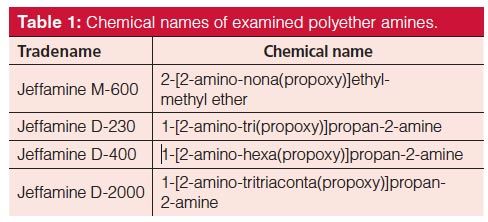
Polyurea resins are formed by the polyaddition of an amine (“A” component) with isocyanate (“B” component). The “A” component consists of polypropylene oxide or polypropyleneâpolyethylene oxide-based polyether amines (1). The chemical names of these amines, which are sold under their trade name, Jeffamines (Huntsman), are shown in Table 1. Polyether amines can vary widely in their molecular weight distribution, chemical composition, and are available in mono-, di-, and trifunctional form. In the latter case, the initial monomer triol is glycerol or trimethylolpropane.
Figure 1: Reaction scheme of adduct formation (monoamine-monoepoxy example).

Epoxy-amine adducts are an important development of the “A” component that are produced by the reaction of an amine and an epoxy compound (2), as shown in Figure 1. Epoxyâamine adducts have a good adhesion to metal surfaces, and, because they are secondary amines, are slower to set than primary amines meaning that pot life (the period of time that the composition of “A” and “B” components remains suitable for its intended processing after mixing) can be regulated by changing the blend of primary and secondary (adduct) amines. It is important to note at this point that the adduct itself contains residual primary amine because the amine conversion of the adduct formation is between 80–100%. For the R&D of new adducts, and even for the quality control of commercial batches, measurement of their residual amine content is needed.
Titration is the standard method of analyzing mixtures of primary, secondary, and tertiary amines (3,4); however, this is only indicative because side-products (such as diamine bound with one epoxy) also form that appear in the primary amine content. Liquid chromatography (LC) is needed after titration to characterize the mixture, because these amines have a relatively long carbon chain. Several studies (5–8) have been published that have determined amines in different resins - among them the principles of qualitative high performance liquid chromatography (HPLC) determination of polyether amines are defined (5,6), but they are used for hydrolysates and relatively short chain amines.
There are several challenges associated with separating polyether amines. Polyether amines and their derivatives are hard to dissolve in water because of their relatively long carbon chain; however, they are soluble in chromatographyâcompatible organic solvents including methanol, acetonitrile, and tetrahydrofuran even when mixed with 50% water (6). In the case of resin residues (5–8), derivatized samples can be injected without further purification, but the solubility of the epoxy-amine adducts has to be tested before sample preparation, and their matrix effect has to be investigated. It can also be difficult to elute native polyether amines, because their amine and ether groups interact with the free silanol groups of RP-18 columns and pH control is needed (6). A solution is to simply derivatize polyether amines.
Alternatives to derivatization include: formation of amide with acetic anhydride and pyridine (5), and derivatization with dinitrofluorobenzene (DNFB) (6,7) and salicylaldehyde (8,9). Unlike amines that require buffer eluent, the derivatives can be eluted with pure water–organic solvent eluent that increases column life. In terms of column choice, there is a trend of increasing efficiency from C18 to C4 columns (5), but DNFB derivatives were separated using a C18 column (6), which can be explained by the lower polarity of the DNFB derivative.
Native polyether amines have poor UV absorption (5), but derivatization using the UV absorbent DNFB, Schiff bases, or acetamide makes UV detection possible. The retention time of derivatization agents must also be considered because they can have a high molar absorption coefficient at UV. When using acetamide derivatization, the pyridine gives a broad peak that has to be eliminated for UV detection (6). Conversely, the peak of DNFB and salicylaldehyde is well separated from sample peaks and does not need further sample treatment (6,8). Salicylaldehyde was used alone in gel permeation chromatography (GPC) (8) and in chelate form also - the latter because of the stability of the product (9). Pyridine is not favourable (10), so amide formation was not taken into consideration. We therefore selected the most convenient derivatization agent from salicylaldehyde and DNFB and the validation was performed.
Materials and Method
Reagents and Solvents: 2-[2-amino-nona(propoxy)]ethyl-methyl ether (Jeffamine M-600), 1-[2-amino-tri(propoxy)]propan-2-amine (Jeffamine D-230), 1-[2-amino-hexa(propoxy)]propan-2-amine (Jeffamine D-400), and 1-[2-amino-tritriaconta(propoxy)]propan-2-amine (Jeffamine D-2000) were purchased from Huntsman. Salicylaldehyde was purchased from Merck. Water for HPLC was purified with a Synergy reagent water system from Millipore. HPLCâgrade acetonitrile and tetrahydrofuran were purchased from Fisher Scientific and dinitrofluorobenzene from Sigma-Aldrich. Samples were weighed with a MettlerâToledo XS-105 half microbalance.
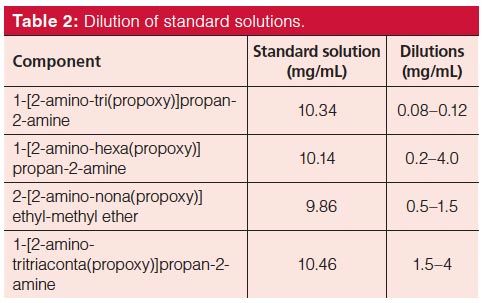
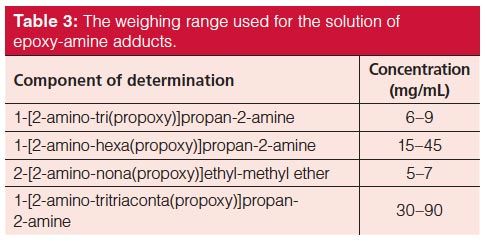
Derivatization: A salicylaldehyde reagent solution of 10 mg/mL was prepared by dissolving 500±5 mg salicylaldehyde in 50 mL of methanol in an amber glass that was then capped for storage. The derivatives of standards were prepared the following way. A sample of each polyether amine (Table 2) was placed in a 10 mL graduated flask, 100 mg of salicylaldehyde was added, and the flask was filled with methanol. The closed flask was shaken thoroughly for 10–20 s, and then aliquots were diluted with the 10 mg/mL salicylaldehyde solution. The time needed for the derivatization at room temperature before injection was determined at the beginning of the validation process. The samples were dissolved in 1 mL of 10 mg/mL salicylaldehyde solution (see preparation of stock solutions) in the quantity corresponding to Table 3. The closed vials were shaken thoroughly for 10–20 s, and aliquots were diluted with the 10 mg/mL salicylaldehyde solution. The time needed for derivatization at room temperature before injection was determined at the beginning of the validation process. Five samples were prepared and measured.
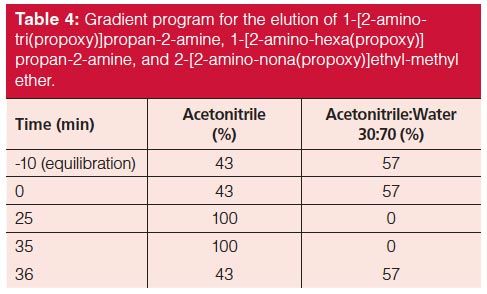
Chromatographic Conditions: A 5-μL volume of sample solution was injected into the HPLC system equipped with a Series 200 quaternary pump, a Series 225 Autosampler, a Series 200 column thermostat, and a Series 200 UV detector (PerkinElmer). For the 2-[2-amino-nona(propoxy)]ethyl-methyl ether, 1-[2-amino-tri(propoxy)]propan-2-amine, and 1-[2-amino-hexa(propoxy)]propan-2-amine samples a 150 × 4.6 mm, 3-μm Gemini C18 column (Phenomenex) was used, while for 1-[2-amino-tritriaconta(propoxy)]propan-2-amine a 150 × 4.6 mm, 3-μm Luna C8 column (Phenomenex) was used. Samples were eluted at a rate of 1 mL/min. Because polyether amines consist of several oligomers whose molecular weight and retention differ greatly, gradient elution had to be used (5–6). First, the elution of 2-[2-amino-nona(propoxy)]ethyl-methyl ether, 1-[2-amino-tri(propoxy)]propan-2-amine, and 1-[2-amino-hexa(propoxy)]propan-2-amine was observed on C4, C8, and C18 columns using an acetonitrile-water gradient (Table 4). Validation was then performed using the column of best efficiency. For the samples containing 1-[2-amino-tritriaconta(propoxy)]propan-2-amine, elution was observed on C4, C8, and C18 columns with a gradient programme corresponding to Table 5. Validation was then performed using the column of best efficiency.
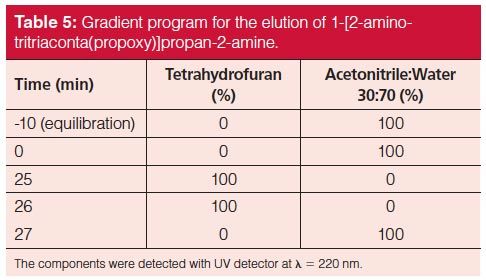
Recovery Measurement: Validation was performed after the following parameters: LOD, LOQ, RSD, and recovery were established. The adduct was weighed in a 2 mL HPLC vial as shown in Table 3, and was then dissolved in a 500-μL solution containing approximately twice as much polyether amine as the weighed sample itself. It was then diluted with 20 mg/mL of 500 μL salicylaldehyde solution and shaken thoroughly. The time needed for the quantitative derivatization at room temperature before injection was determined at the beginning of the validation process. Five parallel samples were measured.
Quantification: For integration the software Totalchrom Workstation 6.2.3 (PerkinElmer) was used. Samples were evaluated with external calibration where the calibration curve was calculated with Open Office Calc 3.1 (Oracle).
Results
Final Method of Measurement: Prevalidation experiments (results not included) showed that DNFB and salicylaldehyde derivatives elute in a similar time but salicylaldehyde has four times higher peak sensitivity. Salicylaldehyde derivatization was therefore selected to validate determination of the primary amines that remained after the adductâforming reaction. Derivatization at room temperature was needed for at least 120 min before injection. Time was saved with bulk sample preparation and autosampling because derivatized solutions could be stored for one day.
The separation of pure 1-[2-amino-tri(propoxy)]propan-2-amine, 1-[2-amino-hexa(propoxy)]propan-2-amine, 1-[2-amino-tritriaconta(propoxy)]propan-2-amine, and 2-[2-amino-nona(propoxy)]ethyl-methyl ether derivatives was evaluated in two parts. The amines of lower molecular weight (2-[2-amino-nona(propoxy)]ethyl-methyl ether, 1-[2-amino-tri(propoxy)]propan-2-amine, 1-[2-amino-hexa(propoxy)]propan-2-amine) were eluted on C4, C8, and C18 columns; efficiency was judged by observing the separation of polyether amine oligomers. For 2-[2-amino-nona(propoxy)]ethyl-methyl ether, 1-[2-amino-tri(propoxy)]propan-2-amine, and 1-[2-amino-hexa(propoxy)]propan-2-amine a trend of column efficiency C4 < C8 < C18 was observed, the inverse of acetamide derivatives (5), meaning that the C4 column did not fulfill the criteria. On the C8 column, 2-[2-amino-nona(propoxy)]ethyl-methyl ether oligomers could not be separated from their contaminants, but, because they are not present in significant quantities in 1-[2-amino-tri(propoxy)]propan-2-amine and 1-[2-amino-hexa(propoxy)]propan-2-amine, they could be eluted on a C8 column.
Figure 2: Chromatograms of polyether amine standards. (Click to Enlarge).
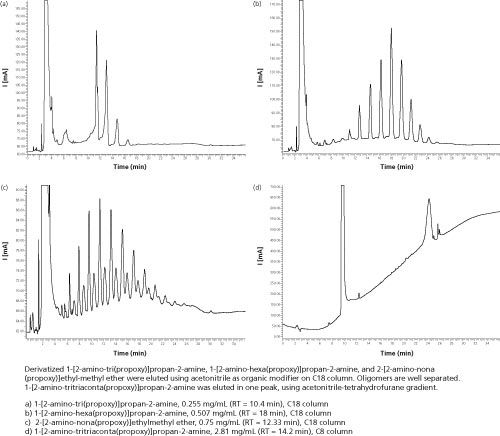
A C18 column was finally chosen for validation because it accomplished the efficiency criteria for each 2-[2-amino-nona(propoxy)]ethyl-methyl ether, 1-[2-amino-tri(propoxy)]propan-2-amine, and 1-[2-amino-hexa(propoxy)]propan-2-amine (Figure 2[a–c]). The chromatogram of the adduct was similar to polyether amine references because the adduct could not be detected; in addition, no contaminant coeluting with polyether amine peaks was detected.
The elution of 1-[2-amino-tritriaconta(propoxy)]propan-2-amine with a water-acetonitrile gradient took a long time and oligomers were not fully separated. Conversely, pure polyether amine could be eluted in one peak using tetrahydrofuran as the stronger eluent on the C18 and C8 column, but the C4 column could not be used because of high peak broadening. Finally, the determination of 1-[2-amino-tritriaconta(propoxy)]propan-2-amine in its epoxy adduct could be validated on a C8 column (Figure 2[d]) because the matrix components of the amine could be separated only in this way (chromatogram not shown).
Quantification: Since oligomer ratio does not change during the adduct formation reaction, peak area was calculated by looking at the base of the highest oligomer peak of 1-[2-amino-tri(propoxy)]propan-2-amine, 1-[2-amino-hexa(propoxy)]propan-2-amine, or 2-[2-amino-nona(propoxy)]ethyl-methyl ether. 1-[2-amino-tritriaconta(propoxy)]propan-2-amine was eluted in one peak so its area could be based on all of its significant oligomers.
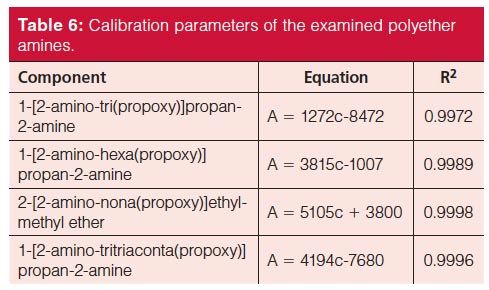
The LOD was the quantity of the component corresponding to the peak height three times that of the baseline noise. For this, a sample of approximately 100 times the signal-to-noise ratio was evaluated using the evaluating graphic interface of the software. The LOQ was calculated by the multiplication of LOD with three. Calibration parameters are shown in Table 6. The analytical parameters are shown in Table 7.

Conclusion
Titration is commonly performed to investigate the residual amine content of polyetheramine epoxide adducts, but amineâmonoepoxy products also need to be characterized. Selective measurement of the residual amine reactant is possible with HPLC when using derivatization, as demonstrated in previous studies (5,6) showing a qualitative approach. A method to quantify primary amines with the use of an UV-absorbent reagent (8) was also considered as a derivatization alternative. Consequently, dinitrofluorobenzene and salicylaldehyde could also be used. Finally, salicylaldehyde derivatization was validated because of the higher UV sensitivity of the derivative.
Two chromatographic elution methods have been developed: for the determination of 1-[2-amino-tri(propoxy)]propan-2-amine, 1-[2-amino-hexa(propoxy)]propan-2-amine, and 2-[2-amino-nona(propoxy)]ethyl-methyl ether, a C18 column was used with an acetonitrile-water gradient. By increasing the initial elution strength, run-time of the previous studies was shortened by 30%. 1-[2-amino-tritriaconta(propoxy)]propan-2-amine could be eluted in one peak with a water/acetonitrile-tetrahydrofuran gradient on a C8 column to eliminate matrix effects. By using a stronger organic modifier than in the previous studies, run-time was shortened by 40%. The RSD was within 5% for each examined polyether amine component.
Derivatization is still a useful strategy because it can be performed easily by dissolving references and samples in solvent containing salycilaldehyde. Even if two hours are required for derivatization, this time can be used for instrument setup and equilibration. Time is saved on column care with derivatization because no buffer and no column wash after analysis is necessary. Detection can be performed at a single wavelength with the commonly available UV detector.
References
- http://www.huntsman.com/portal/page/portal/performance_products/Media%20Library/global/files/jeffamine_polyetheramines.pdf [Downloaded: 2 June 2015]
- G. Nagy, F. Balazs, and Gy. Cselik, EP Patent 2470581 B1
- S. Siggia, J.G. Hanna, and I.R. Kervenski, Anal. Chem.22, 1295–1297 (1950).
- F.G. Garcia, P.M. da Silva, B.G. Soares, and J.R. Briones, Polymer Test. 26, 95–101 (2007).
- Klaus Rissler, J. Chromatography A 667, 167–174 (1994).
- U. Fuchslueger, K. Rissler, H.-J. Grether, and M. Grasserbauer, Fresenius J Anal. Chem. 356, 495–499 (1996).
- M.G. Gioia, P. Andreatta, S. Boschetti, and R. Gatti, J. Pharma. and Biomed. Anal. 45, 456–464 (2007).
- P. Bauer and M. Richter, J. Chromatography 206, 343–352 (1981).
- Ekhard Winkler, Eberhard Hohaus, and Eugen Felber, J. Chromatography 436, 447–454 (1988).
- MSDS of pyridine: http://caledonlabs.com/upload/msds/8700-1e.pdf [Downloaded: 2 June 2015]
Jenó´ Fekete is a Professor Emeritus and tutor in the Department of Inorganic and Analytical Chemistry at the Doctoral School of Budapest University of Technology and Economics (BUTE, Hungary) and at the Eötvös Loránd University (Budapest, Hungary). He holds a CSc, PhD in Chemical Sciences from the Hungarian Academy of Sciences. He has a citation index of 984.
Ló´rinc Garai has a M.Sc in bioengineering from the Budapest University of Technology and Economics, Hungary, and a computer programming degree from Kandó Kálmán Faculty of Electrical Engineering at Óbuda University, Hungary. He was with Polinvent Ltd. in Hungary and now works at an international pharmaceutical company. His interests include analytics in polymer chemistry and HPLC analytics of pharmaceutical products.
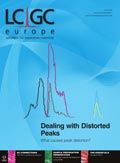
Maximizing Cannabinoid Separation for Potency Testing with LC
April 7th 2025Researchers from the Department of Chemistry at Western Illinois University (Macomb, Illinois) conducted a study to optimize the separation of 18 cannabinoids for potency testing of hemp-based products, using liquid chromatography with a diode array detector (LC–DAD). As part of our monthlong series of articles pertaining to National Cannabis Awareness Month, LCGC International spoke to Liguo Song, the corresponding author of the paper stemming from this research, to discuss the study and its findings.
How Many Repetitions Do I Need? Caught Between Sound Statistics and Chromatographic Practice
April 7th 2025In chromatographic analysis, the number of repeated measurements is often limited due to time, cost, and sample availability constraints. It is therefore not uncommon for chromatographers to do a single measurement.










